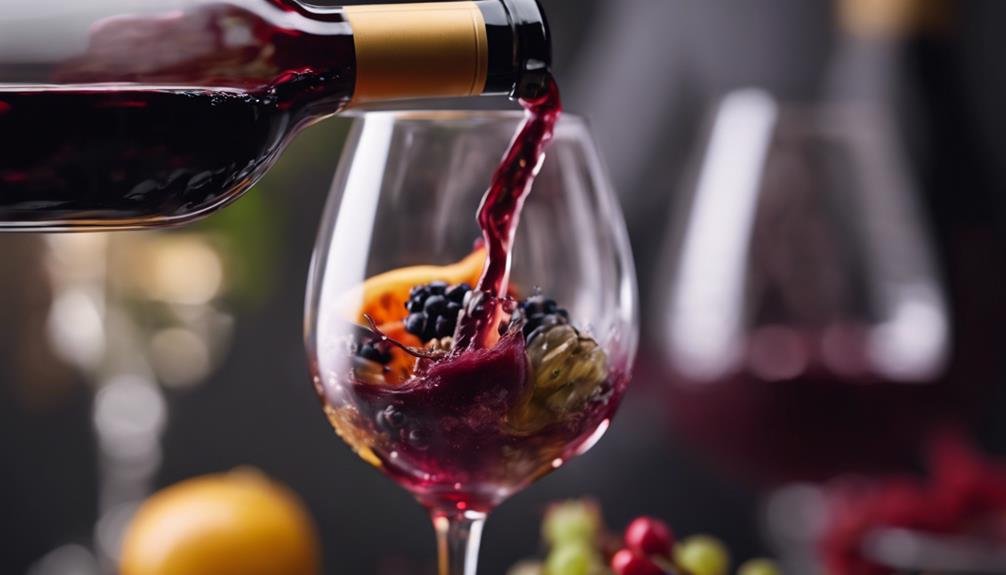Revealing the secrets behind wine aromas uncovers a fascinating world of aromatic compounds. Fruity esters in Chardonnay and Grenache offer a fruity twist, while pyrazines in Cabernet Franc and Sauvignon Blanc add herbaceous notes. Terpenes bring hints from sweet florals to resinous scents, and thiols introduce grapefruit and black currant tones. Eucalyptus notes are unique to Australian Shiraz. Earthy tones like geosmin and sulphur compounds evoke soil and mushroom scents. Spicy aromas like rotundone and lactones provide peppercorn, vanilla, and coconut scents. Exploring these components deepens wine appreciation and enriches the tasting experience with intricate flavor profiles awaiting discovery.
Exploring Key Aroma Compounds
Delving into the domain of wine aromas entails unraveling the intricate web of key aroma compounds that contribute to the diverse flavor profiles found in various wines. Understanding chemical composition is essential in deciphering the sensory exploration of wines.
Esters, such as those found in Chardonnay and Grenache, provide fruity nuances, while pyrazines offer herbaceous notes present in Cabernet Franc and Sauvignon Blanc. Terpenes add a range of scents from sweet floral to resinous hints. Thiols introduce grapefruit tones in Sauvignon Blanc and black currant aromas in Bordeaux wines. Eucalyptus notes can be detected in Australian Shiraz.
Unveiling Fruit and Floral Essences
Uncovering the intricate interplay of fruit and floral essences in wine reveals a spectrum of delicate aromas that contribute to the sensory experience of tasting. By identifying aromatic esters like apple in Chardonnay and raspberry in Grenache, wine enthusiasts can appreciate the nuances of fruity notes that enhance the tasting journey.
Additionally, discovering fruity pyrazines, such as bell pepper in Cabernet Franc and grass in Sauvignon Blanc, adds a layer of complexity to the aromatic profile of wines. These compounds, along with terpenes like lychee in Gewürztraminer and lavender in Grenache, create a sensory tapestry that delights the palate.
Understanding and recognizing these fruit and floral essences can elevate the enjoyment of wine tasting, allowing for a deeper appreciation of its flavors and aromas.
Delving Into Earthy Undertones

Exploring the aromatic complexities of wine extends beyond fruit and floral essences to reveal the distinct earthy undertones that contribute to the multifaceted sensory experience of wine tasting. When delving into earthy undertones in wine, two key components play a significant role:
- Geosmin exploration: Revealing the earthy aroma compound that evokes soil and mushroom scents in certain wines.
- Sulphur compounds analysis: Understanding how sulfur compounds like chalk in Chablis and metallic notes in young red wines impact the overall flavor profile.
- Volatile acidity impact: Recognizing how volatile acidity adds complexity to wines, with examples like balsamic notes in Chianti showcasing the diverse range of earthy undertones in wine.
Deciphering Spicy Aromatics
Understanding the intricate nuances of spicy aromatics in wine elevates the sensory experience by revealing layers of peppery, smoky, and aromatic complexity. Identifying pepper notes is essential to appreciating the diverse range of spice complexity in wines.
Rotundone, for example, imparts peppercorn characteristics to wines like Syrah and Cabernet Sauvignon, adding a distinctive spicy element. Lactones contribute vanilla and coconut scents, particularly in oak-aged wines, enhancing the overall aromatic profile. Thiols play a vital role in providing smoky and chocolate aromas, enriching the sensory journey of wine tasting.
Enhancing Wine Tasting Knowledge

To expand one's expertise in wine tasting, a deeper understanding of the diverse aroma compounds that contribute to the intricate flavor profiles of wines is invaluable.
- Enhancing Sensory Perception
- Exploring Key Flavor Components
- Utilizing Aromatics for Wine Appreciation
Understanding sensory perception and the nuances of flavor components can greatly enrich one's wine tasting experience. By delving into the various aroma compounds present in wines, individuals can develop a more profound appreciation for the complexities of different varietals.
Enhancing sensory perception allows for a deeper exploration of the subtle notes and nuances that define each wine. By focusing on key flavor components, such as fruit, floral, herbal, spice, and earthy elements, one can further refine their palate and cultivate a sophisticated understanding of wine tasting.
Frequently Asked Questions
How Do Different Grape Varieties Impact Wine Aromas?
Different grape varieties impact wine aromas through their unique chemical compositions influenced by soil composition, climate, and fermentation process. Understanding these factors is essential in appreciating the diverse aromatic profiles that each grape varietal contributes to wine.
Can the Same Aroma Compound Smell Different in Various Wines?
In the intricate world of wine, the same aroma compound can evoke distinct scents in various wines due to chemical reactions and perception variations. Understanding this phenomenon enhances appreciation for the complexity of wine aromas.
Are There Specific Aroma Compounds Responsible for Wine Aging Potential?
Wine chemistry plays a vital role in determining aging potential. Specific aroma compounds, such as tannins, phenols, and esters, influence a wine's ability to evolve gracefully over time. Understanding these compounds can help predict how a wine will mature.
What Role Do Oak Barrels Play in Shaping Wine Aromas?
Oak aging in wine production is pivotal for shaping aromas, with oak barrels imparting flavors such as vanilla, spice, and toast. Barrel influence varies based on oak type, toasting level, and time, adding complexity and texture to wines.
How Can Environmental Factors Influence Wine Aroma Development?
Climate effects and vineyard location impact wine aroma development by influencing grape ripening. Soil composition and microbial activity in the vineyard contribute to the absorption of essential nutrients, further shaping wine aromas. These environmental factors play an important role in wine production.
Conclusion
To sum up, the intricate world of wine aromas offers a sensory journey of discovery. By unraveling the secrets behind key aroma compounds and exploring fruit, floral, earthy, and spicy essences, one can enhance their wine tasting knowledge and appreciation.
What hidden stories will your next bottle of wine reveal through its aromatic symphony?